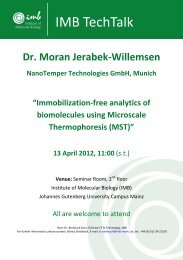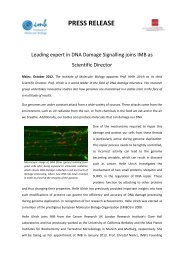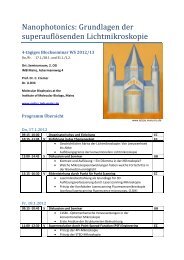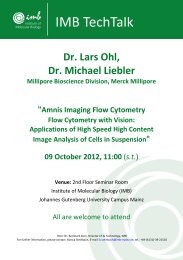Low-resolution PDF - IMB
Low-resolution PDF - IMB
Low-resolution PDF - IMB
Create successful ePaper yourself
Turn your PDF publications into a flip-book with our unique Google optimized e-Paper software.
T h e d y n a m i c s o f g e n e e x p r e s s i o n a n d D N A d e m e t h y l a t i o n<br />
12<br />
“We have identified novel<br />
small molecules that provoke<br />
re-expression of silenced<br />
tumour suppressor loci.”<br />
George Reid<br />
Education<br />
1984 BSc in Biochemistry, University of Strathclyde<br />
1988 PhD in Biochemistry, University of Strathclyde<br />
Positions held<br />
1984 - 1985 Research Assistant, Turing Institute, Glasgow<br />
1988 - 1993 Postdoctoral Researcher, MRC Retrovirus Research<br />
Laboratory, Glasgow<br />
1994 - 1996 Senior Scientist, Pfizer Central Research, Sandwich<br />
1996 - 1998 Postdoctoral Researcher, Beatson Institute for Cancer<br />
Research, Glasgow<br />
1999 - 2004 Postdoctoral Researcher, EMBL, Heidelberg<br />
2004 - 2010 Staff Scientist, EMBL, Heidelberg<br />
Since 2006<br />
Since 2010<br />
Group Members<br />
Co-founder and Executive of Elara Pharmaceuticals<br />
Group Leader, Institute of Molecular Biology (<strong>IMB</strong>),<br />
Mainz<br />
Iryna Charapitsa / Postdoc; since 07/2011<br />
Christof Fritzsch / PhD student; since 09/2012<br />
Wolf Gebhardt / Postdoc; since 08/2011<br />
Ina Kirmes / PhD student; since 06/2012<br />
Monika Kuban / Research Assistant; since 10/2012<br />
Research Overview<br />
The functional template of gene expression is chromatin. This provides<br />
multiple regulatory barriers that have to be overcome prior to<br />
the initiation of RNA synthesis. Dynamic methylation of DNA has been<br />
demonstrated by us to be an inherent process in the expression of<br />
tightly regulated genes. Using estrogen mediated gene expression<br />
as a model system, we are describing, on a genome-wide scale,<br />
changes on the chromatin template that determine the timing and<br />
output of transcriptional processes. Moreover, based on our detailed<br />
description of these dynamics we have devised a high-throughput<br />
screen to discover novel small molecules that perturb dynamic<br />
methylation. In addition to being useful biotools with which to further<br />
explore transcriptional regulation, they may define new therapeutic<br />
approaches for controlling tumour growth by provoking re-expression<br />
of silenced tumour suppressor loci.<br />
Research highlights<br />
As a partner within a pan-european consortium of experimental and<br />
computational biologists (SYNERGY), we have generated global profiles<br />
of chromatin in estrogen dependent breast cancer cells following<br />
their synchronous release from estrogen starvation. This massively<br />
parallel sequence dataset includes time series of RNA expression,<br />
polymerase II, estrogen receptor alpha and variant histone H2AZ<br />
occupancy and DNA methylation profiles. Data have also been<br />
generated on covalent modifications to histone tails, in particular<br />
acetylation and methylation. By combining recent technical improvements<br />
in sequencing with state-of-the-art bioinformatics and computational<br />
biology with a tightly regulated pathway that signals to<br />
chromatin, these integrated and comprehensive datasets provide a<br />
wealth of information that promises to provide profound insight into<br />
eukaryotic gene regulation. Additionally, in collaboration with the<br />
Legewie group, we are using ChIP on synchronized cell populations,<br />
fluorescently labelled reporter arrays and transcription factors in<br />
single cells to further explore and model the dynamics of transcriptional<br />
cycling.










